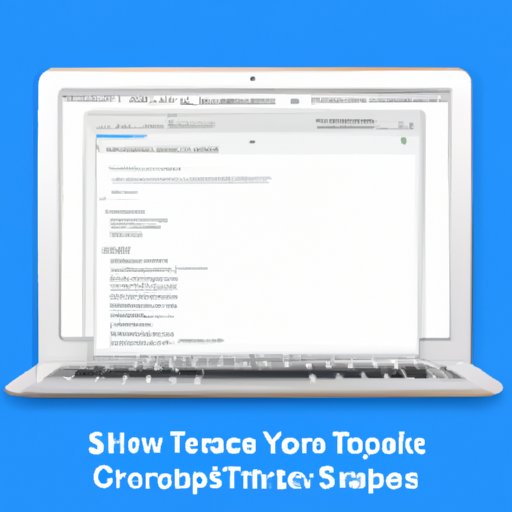Introduction
Have you ever found yourself needing to take a screenshot on your MacBook, but you’re not sure how? Taking a screenshot can be useful for a variety of reasons, including capturing important information, saving a memorable chat message, or even just showing off your desktop background. In this article, we’ll explore the different ways to take a screenshot on your MacBook, including step-by-step instructions, keyboard shortcuts, screenshot tools, troubleshooting tips, and even some advanced techniques for more experienced users.
Step-by-Step Guide
The easiest way to take a screenshot on your MacBook is to use the built-in screenshot tool. Here’s how:
- Open the screen that you want to capture.
- Press command + shift + 5. This will open the screenshot toolbar on your screen.
- Select the capture type you want to take from the options available on the toolbar. You can select to take a screenshot of the entire screen, a selected window, or a portion of the screen.
- Choose the required delay as necessary for the screenshot.
- Click on Capture or use Record Entire Screen or Record Selected Portion for the video capture feature when screen recording is what you need.
- The screenshot will be saved to your desktop by default.
If you’re looking to edit or annotate your screenshot, you can do so by clicking on the screenshot preview that appears on the bottom right-hand corner of the screen. This will open the markup window, where you can edit your screenshot as necessary. Once you’re done, you can either save your edits by clicking Done or discard your changes by clicking Cancel.
Keyboard Shortcuts
If you’re a fan of keyboard shortcuts, there are several options available for taking screenshots on your MacBook:
- To capture the entire screen, press command + shift + 3. The screenshot will be saved to your desktop by default.
- To capture a selected portion of the screen, press command + shift + 4. This will turn your cursor into a crosshair pointer, allowing you to select the area of the screen that you want to capture.
- To capture a specific window, press command + shift + 4, followed by the spacebar. This will turn your cursor into a camera pointer, allowing you to select the window that you want to capture.
The advantage of keyboard shortcuts is that they’re quick and easy to use, especially once you’ve memorized them. However, they can also be a bit fiddly if you’re not used to them, so it’s worth practicing a few times until you get the hang of it.
Screenshot Tools
There are several third-party screenshot tools available for MacBooks, each offering their own unique features and advantages:
- Jing: Jing is a free screenshot tool that allows you to capture images and video, add basic annotations, and share your captures online.
- Snagit: Snagit is a more advanced screenshot and video tool that offers advanced editing features, as well as the ability to capture scrolling web pages.
- Lightshot: Lightshot is a simple and lightweight screenshot tool that allows you to capture and edit screenshots, as well as upload them to the cloud for easy sharing.
The advantage of using a third-party screenshot tool is that they often offer more advanced features than the built-in macOS tool, such as the ability to capture scrolling pages or advanced editing options. However, they can also be more complex to use, so it’s worth choosing a tool that’s suited to your needs and skill level.
Troubleshooting
If you’re having trouble taking a screenshot on your MacBook, there are a few common issues that you might encounter:
- The screenshot doesn’t save to your desktop: If the screenshot doesn’t save to your desktop, it’s possible that your MacBook is saving screenshots to a different location. You can check by searching for “Screenshots” in Finder.
- The screenshot is blank: If the screenshot appears blank, it’s possible that your MacBook’s permissions settings are preventing the screenshot from capturing the screen. Try checking your system preferences to make sure that permissions are enabled for screenshots.
- The screenshot is the wrong size: If the screenshot is the wrong size or resolution, it’s possible that your MacBook’s display settings are affecting the size of the screenshot. Try adjusting your display settings and taking the screenshot again.
If you’re still having trouble, it’s worth consulting the Apple Support community or contacting Apple support directly for more assistance.
Advanced Tips
If you’re looking to take your screenshot game to the next level, there are several advanced techniques that you can try:
- Timed screenshots: If you need to capture a pop-up or other transient content that appears on your screen, you can use the command + shift + 5 keyboard shortcut and choose a timed screenshot.
- Terminal commands: If you’re comfortable using the Terminal app on your MacBook, you can use various commands to customize the format and output of your screenshots, such as changing the file format or saving screenshots to a specific folder.
These techniques are more advanced, so it’s worth doing some research before attempting them. However, they can be useful for more specialized use cases and can help you take your screenshots to the next level.
Conclusion
In conclusion, taking a screenshot on your MacBook is a simple and useful task that can be accomplished in several different ways. Whether you prefer the built-in screenshot tool, keyboard shortcuts, or third-party apps, there’s a solution that’s right for you. With the tips and tricks outlined in this article, you’ll be able to capture and edit screenshots like a pro in no time.
If you’re looking for more resources or support, be sure to check out the Apple Support community or the official Apple support website.
